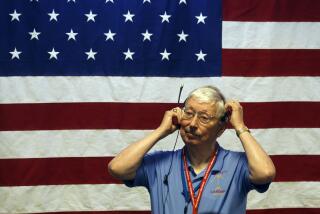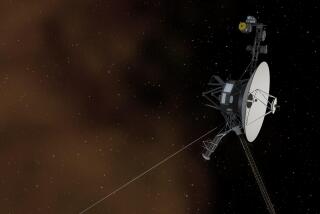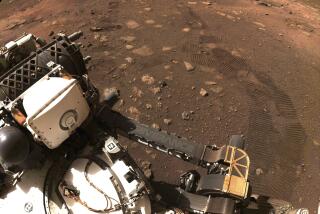Scientists Put Mars Rover Named FIDO Through Its Paces in Nevada
- Share via
BLACK ROCK SUMMIT, Nev. — The six-wheeled rover inched over the gravel of a wind-swept hillside, carefully avoiding boulders and precipices in a slow-motion hunt for a rock that struck the fancy of distant planetary scientists.
But there was a problem. One of the steel-cleated wheels was dragging like a broken shopping cart, and the engineers in Pasadena couldn’t figure out what was wrong. They beamed commands to budge the faraway robot back and forth, left and right. No luck.
A voice finally crackled through a speaker in mission control: Try the belly camera to check for obstructions--such as the rock lodged under a wheel.
The planetary rover named FIDO was soon on its way.
If FIDO had been on Mars, the troubleshooting would have wasted valuable hours. This time, the rover was being tested in desolate central Nevada, a spot that rivals Mars in emptiness but can support space-age driving instructors.
“You don’t want a $200-million mission to Mars to be the first time you’ve tried the rover,” said Kris Larsen, one of the shivering researchers at Black Rock Summit and a graduate student at Washington University in St. Louis.
Larsen and about a dozen other researchers spent two weeks in May baby-sitting FIDO and a companion named K9 in the shadow of the Pancake Mountains, between Tonopah and Ely.
Their mission was to monitor the coffee table-size robot as it was controlled by satellite from NASA’s Jet Propulsion Laboratory, nearly 400 miles away in California. Several rock-sniffing-and-scraping science instruments also were tested.
Though FIDO and other prototypes will never see the surface of Mars, their experience on Earth will be incorporated into future rovers such as Athena, which could fly in a mission as early as 2003.
NASA is expected to announce plans for that mission this month. Earlier, the agency confirmed it would choose either a large orbiter or a surface rover that would land using large air bags--the same as Mars Pathfinder in 1997.
The decision will end months of uncertainty after last year’s failures of the Mars Polar Lander and the Mars Climate Orbiter.
“We went from being planned for the 2003-2005 missions to not being planned to being a prime contender for 2003,” Larsen said. “We stand a really good chance of going to Mars in the next few years.”
NASA spent about $1.2 million to build a half-dozen rover prototypes.
To add to the realism of the Nevada test, mission navigators in Pasadena did not know the rover’s location except that it was somewhere in the United States. They had to image the area, plot the course and find interesting rocks.
Nobody sits in the control room with a joystick; it would take 20 minutes for a signal to reach Mars, millions of miles away. The rover’s commands are planned in advance and then beamed to the planet.
FIDO, which stands for the Field Integrated Design and Operations rover, is about the size of a St. Bernard, roughly twice as large as the Sojourner robot that roamed the Red Planet in 1997. Aside from size, FIDO carries a strong family resemblance.
The larger robot can drive for miles, as opposed to the 330 feet traveled by Sojourner during its mission. FIDO’s 8-inch wheels can drive over rocks 12 inches tall, as opposed to the 6-inch obstacle barrier traversed by Sojourner.
Sojourner stopped every 4 inches to survey its surroundings, but FIDO’s eyes can detect obstacles up to 5 feet ahead. And though the larger rover is no speed demon at .13 mph, it’s about 10 times faster than Sojourner.
“FIDO keeps a history of where it’s been, so if it gets into an area where it’s trapped, it knows how to back out safely,” said Terry Huntsberger, a senior JPL technical staff member. “The safety aspect is the most important thing.”
An icy wind blew though a canyon not far from an ancient lava flow. FIDO’s electronics hummed softly behind a ridge several hundred feet away from the trailers, satellite dishes and portable toilets where the researchers set up camp.
Last year’s tests took place in the Mojave Desert, outside Baker, Calif. This time, researchers wanted to focus on some of the rover’s science instruments, so they selected the geologically interesting but isolated Black Rock Summit.
Lava flowed through the area about 100,000 years ago, and minerals in the area were weathered by water. Similar findings on Mars would be a major discovery in the search for past or present life because water is such an important ingredient.
“This would be the ideal kind of rock to find on Mars,” Huntsberger said. “It’s a smoking gun.”
Huntsberger and his JPL engineer, Brett Kennedy, watched the clouds carefully for any sign of rain that could cut short the day’s mission--running commands created by a group of Dutch high school students who won a competition.
For more than two hours, the two waited next to the motionless machine, occasionally radioing the camp to find out what the delay might be. The students, who were at JPL mission control, were reworking their commands.
After a two-hour wait, the sequence from Pasadena was finally received by the control trailer and instantly sent by a relay antenna to the rover, humming motionless behind a ridge.
Almost imperceptibly, the mast began to rise to take pictures of the landscape. Fully extended, it reached more than six feet above the flat top of the rover’s solar panels.
A few minutes into the sequence, sprinkles began to fall. Kennedy and Huntsberger grabbed a gold tarp and covered the machine’s sensitive electronics.
The sprinkles turned to rain.
“Abort the sequence,” Huntsberger radioed to the control trailer.
After a change of batteries and a break in the rain several minutes later, the rover sprang back to life, carried on its mission of science and managed to return to its home base on a mock lander planted at the top of the ridge 100 feet away.
Even in the middle of nowhere, the enterprise attracted some attention.
Rosie Garaventa’s class of five schoolchildren arrived unannounced from the Duckwater Shoshone Indian tribe. They gathered around the rover as Kennedy pointed out its features.
“What do you guys think?” he asked.
“Cool!” the children chimed.
“Got any questions?” he asked.
“What does it do?” 8-year-old Odome Jackson asked.
The children eventually left, and Kennedy and Huntsberger resumed their long wait for another set of sequences to be downloaded. Next year the rover team could find itself in an even more remote area.
“They’re threatening Antarctica,” Larsen said.
*
On the Net: NASA’s Jet Propulsion Laboratory:
https://www.jpl.nasa.gov
FIDO home page:
https://wufs.wustl.edu/rover/
More to Read
Sign up for Essential California
The most important California stories and recommendations in your inbox every morning.
You may occasionally receive promotional content from the Los Angeles Times.










